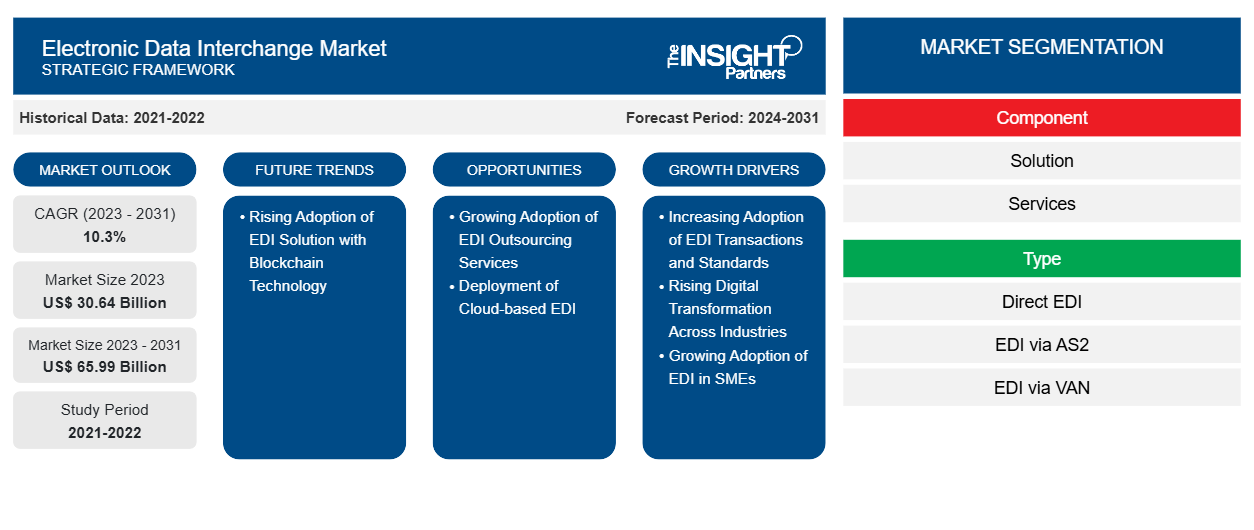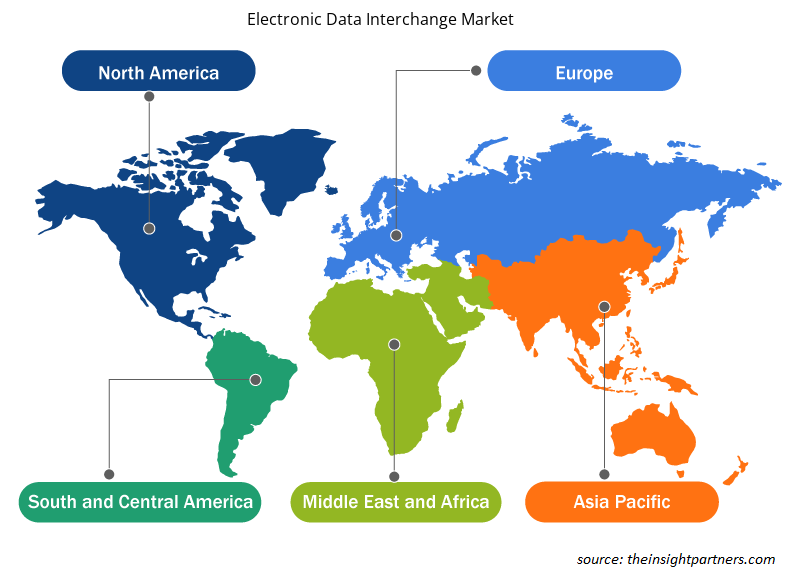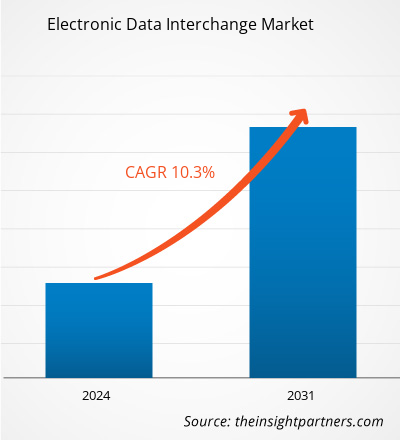电子数据交换市场规模预计将从2024年的340.2亿美元增至2031年的743.6亿美元。预计2025年至2031年期间,该市场的复合年增长率将达到11.9%。电子数据交换(EDI)解决方案与区块链技术的融合,很可能在未来几年为市场带来新的趋势。
电子数据交换市场分析
EDI 解决方案需要持续维护,因为组织业务的整体工作流程依赖于它。许多组织认为 EDI 必须遵守众多合规性和标准。这阻碍了小型企业与大型组织合作部署更新版本的文档标准。这些组织直接与客户交换 EDI 文档,或使用第三方服务提供商。随着业务文档数字化以提高处理效率的趋势日益增长,多项合规性要求应运而生,这推动了全球范围内从纸质发票向电子发票的转变。
金融服务、保险和保险业(BFSI)、零售和制造业的数字化转型和EDI解决方案在数据交易领域的应用日益普及,加之EDI相关的合规性要求不断提高,以及政府为推动EDI解决方案采用而推出的优惠举措,这些都是推动全球EDI解决方案需求增长的关键因素。然而,EDI的缺点是实施成本高昂,且解决方案的部署耗时。尽管存在这些局限性,但随着EDI交易和标准的日益普及,以及各行各业数字化转型的不断推进,预计将在预测期内推动市场增长。
电子数据交换市场概况
EDI 是一种自动化流程,企业可以通过电子方式交换发票、采购订单、预发货通知、海关、付款、库存、提单和运输状态等文件。EDI 使企业能够规范供应链应用程序之间的数据交换,并保证关键业务数据按时发送。EDI 取代了传统的邮件准备和处理业务沟通方式。EDI 解决方案使企业能够提升整体工作流程的效率。快速准确的 EDI 文档处理可以减少重复工作,并降低订单取消和缺货率。
您可以免费定制任何报告,包括本报告的部分内容、国家级分析、Excel 数据包,以及为初创企业和大学提供优惠和折扣
电子数据交换市场:战略洞察

- 获取此报告的顶级关键市场趋势。此免费样品将包括数据分析,从市场趋势到估计和预测。
电子数据交换市场驱动因素和机遇
中小企业越来越多地采用EDI
EDI 在中小企业中被广泛使用。由于中小企业 (SME) 资源和人力资本匮乏,EDI 支持它们实现流程自动化,而非依赖传统方法。它允许在整个电子交换过程中,根据全球和区域 EDI 规则和标准共享各种文档和数据。它涵盖传输、消息流、文档格式以及中小企业用于发送和接收文档的软件。全球中小企业的增长带来了自动化交易数量的增加,从而催生了中小企业对 EDI 解决方案的需求。例如,根据欧盟委员会 (EU) 2024 年 7 月的数据,欧洲中小企业数量增长了 5.4%,就业率增长了 4.8%。2021 年至 2023 年间,该地区中小企业的总体增长率达到了 4.5%。这种增长增加了业务活动的数量,并激增了对 EDI 解决方案的需求,以简化运营、提高运营效率并减少过多的 IT 开销。 EDI 解决方案使中小企业能够以电子方式无缝交换采购订单和发票等关键文件,避免手动流程和文书工作。这可以加快订单处理速度、减少错误并改善库存管理,从而提升整体业务绩效。
此外,数字化进程的加快和对自动化解决方案日益增长的需求,促使中小企业采用基于云的解决方案。云解决方案可实现 EDI 流程的诸多方面自动化,例如验证、数据映射、格式转换、简化工作流程以及减少手动数据输入。根据 Public First 于 2024 年进行的调查,85% 使用云服务的受访中小企业认为,使用云服务使他们更容易与大型企业竞争。EDI 解决方案的普及可以为 EDI 提供商带来更高的收入。因此,供应商正在努力使 EDI 解决方案更经济实惠、更易于获取,以扩展其业务。此外,投资 EDI 的中小企业能够与大型企业进行交易,同时处理更多业务。总体而言,EDI 帮助中小企业提高运营效率,同时允许他们处理更多交易并与大型企业开展业务。因此,中小企业对 EDI 的日益普及推动了电子数据交换市场的增长。
EDI外包服务需求不断增长
EDI 项目的外包是通过托管服务进行的,即为第三方供应商管理和实施 EDI 平台。外包供应商通常提供基于云的解决方案或服务,支持企业安全地交换采购订单、发票和装运通知等文件。外包需要企业获得广泛的硬件和软件能力以及资本投入。许多公司正积极致力于将 EDI 与其后台系统集成,包括帮助企业满足内部资源需求的 ERP 系统。此外,采用托管服务方式进行 EDI 因其显著的优势而受到企业的欢迎,例如:
- 基于云的托管 EDI 外包服务支持企业与贸易伙伴协调验证数据流并进行端到端 EDI 测试
- 根据贸易伙伴需求的变化提供自动内部更新
- 支持 EDI 交易和维护计划的内部监控和优化
- 贸易伙伴、系统、销售渠道和 EDI 服务专家提供全天候支持
- 提供持续监控,以最大限度地减少数据输入并防止错误
EDI外包的实施比IT行业其他领域的外包更具吸引力。EDI外包旨在降低基础设施成本,确保数据交换准确及时,快速适应贸易伙伴需求的变化,并确保获得为客户提供服务的适当技能。EDI外包的实施具有多种优势,例如能够使用最新技术、连接外部系统以及提供增值服务,使用户能够在全球范围内进行贸易。EDI允许用户快速进入新市场,从而增强业务敏捷性,并通过提供与绩效、供应链和业务合作伙伴相关的高级信息来提高业务生产力。因此,预计EDI外包服务需求的不断增长将为预测期内电子数据交换市场的增长创造机遇。
电子数据交换市场报告细分分析
有助于得出电子数据交换市场分析的关键部分是组件、类型和行业。
- 根据组件,市场分为解决方案和服务。2024年,解决方案领域占据市场主导地位。
- 就类型而言,市场分为直接EDI、通过AS2的EDI、通过VAN的EDI、移动EDI、Web EDI、EDI外包和其他类型。2024年,通过VAN的EDI占据了市场主导地位。
- 根据行业,电子数据交换市场分为BFSI、医疗保健、零售和消费品、IT和电信、运输和物流、汽车、食品和饮料等。2024年,零售和消费品领域占据了市场主导地位。
电子数据交换市场份额(按地区)分析
电子数据交换市场分为五大区域:北美、欧洲、亚太地区、中东和非洲(MEA)以及南美。北美在2024年占据市场主导地位。
北美拥有多家科技巨头,它们在开发强大的技术方面投入了大量资金。随着B2C和B2B数据交易的持续增长,预计许多组织及其合作伙伴未来将实现业务增长。许多企业对EDI解决方案表现出浓厚的兴趣,希望能够准确、高效、安全地交换数据。美国有多家服务提供商提供自动化EDI解决方案。EDI解决方案的采用提高了美国政府各部门的效率并节省了成本。此外,由于新兴技术和各组织对云端系统的投资,该地区的EDI实施正在逐渐兴起。
电子数据交换市场区域洞察
Insight Partners 的分析师已详尽阐述了预测期内影响电子数据交换市场的区域趋势和因素。本节还讨论了北美、欧洲、亚太地区、中东和非洲以及南美和中美洲的电子数据交换市场细分和地域分布。

- 获取电子数据交换市场的区域特定数据
电子数据交换市场报告范围
| 报告属性 | 细节 |
|---|---|
| 2024年的市场规模 | 340.2亿美元 |
| 2031年的市场规模 | 743.6亿美元 |
| 全球复合年增长率(2025-2031) | 11.9% |
| 史料 | 2021-2023 |
| 预测期 | 2025-2031 |
| 涵盖的领域 | 按组件
|
| 覆盖地区和国家 | 北美
|
| 市场领导者和主要公司简介 |
|
电子数据交换市场参与者密度:了解其对业务动态的影响
电子数据交换市场正在快速增长,这得益于终端用户需求的不断增长,而这些需求的驱动因素包括消费者偏好的演变、技术进步以及对产品优势的认知度的提升。随着需求的增长,企业正在扩展产品线,不断创新以满足消费者需求,并抓住新兴趋势,从而进一步推动市场增长。
市场参与者密度是指特定市场或行业内企业或公司的分布情况。它表明特定市场空间内竞争对手(市场参与者)的数量相对于其规模或总市值而言。
在电子数据交换市场运营的主要公司有:
- Salesforce公司(MuleSoft)
- SPS Commerce, Inc.
- TrueCommerce公司
- IBM 公司
- 克莱奥
- Generix集团
免责声明:以上列出的公司没有按照任何特定顺序排列。

- 获取电子数据交换市场顶级关键参与者概览
电子数据交换市场新闻及最新发展
电子数据交换市场评估通过收集一手和二手研究后的定性和定量数据进行,这些数据包括重要的公司出版物、协会数据和数据库。以下列出了电子数据交换市场的一些发展情况:
- Cleo 宣布与 Programmers.io 建立合作伙伴关系。Programmers.io 是一家领先的服务提供商,为制造、运输、保险和零售行业的企业提供 AI 支持和技术解决方案。此次战略合作将 Cleo Integration Cloud (CIC) 的强大功能与 Programmers.io 深厚的技术专长相结合。双方将携手提供量身定制的 EDI 和 API 集成,并随着客户需求的增长无缝扩展业务运营。
(来源:利宝互助保险,新闻稿,2025 年 3 月)
- AWS B2B 数据交换支持使用生成式 AI 生成电子数据交换 (EDI) 映射代码。这项新功能加快了编写和测试双向 EDI 映射的流程,从而减少了将 EDI 工作负载迁移到 AWS 所需的时间、精力和成本。AWS B2B 数据交换是一项完全托管的服务,可自动大规模转换业务关键型 EDI 交易,并具有弹性和按使用量付费的定价模式。
(来源:Liberty Mutual Surety,新闻稿,2024 年 11 月)
电子数据交换市场报告覆盖范围和交付成果
“电子数据交换市场规模和预测(2021-2031)”对以下领域进行了详细的市场分析:
- 范围内涵盖的所有主要市场领域的全球、区域和国家层面的电子数据交换市场规模和预测
- 电子数据交换市场趋势以及市场动态,例如驱动因素、限制因素和关键机遇
- 详细的 PEST 和 SWOT 分析
- 电子数据交换市场分析涵盖主要市场趋势、全球和区域框架、主要参与者、法规和最新市场发展
- 行业格局和竞争分析,包括市场集中度、热图分析、知名参与者以及电子数据交换市场的最新发展
- 详细的公司简介
- 历史分析(2 年)、基准年、预测(7 年)及复合年增长率
- PEST和SWOT分析
- 市场规模、价值/数量 - 全球、区域、国家
- 行业和竞争格局
- Excel 数据集
近期报告
相关报告
客户评价
购买理由
- 明智的决策
- 了解市场动态
- 竞争分析
- 客户洞察
- 市场预测
- 风险规避
- 战略规划
- 投资论证
- 识别新兴市场
- 优化营销策略
- 提升运营效率
- 顺应监管趋势




















 获取免费样品 - 电子数据交换市场
获取免费样品 - 电子数据交换市场